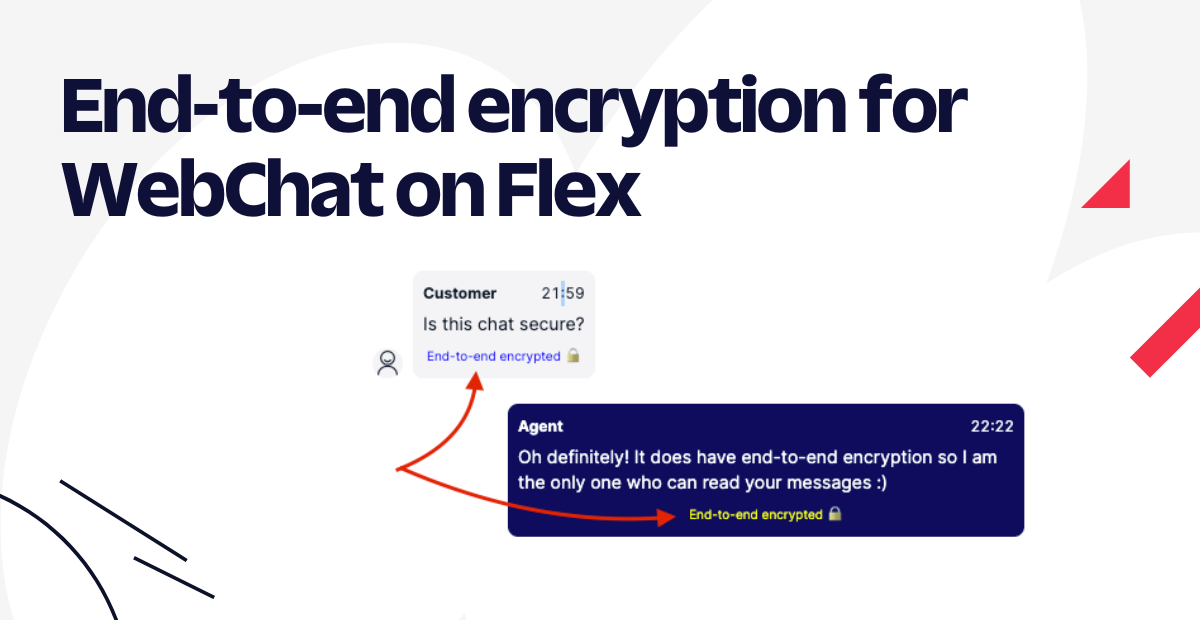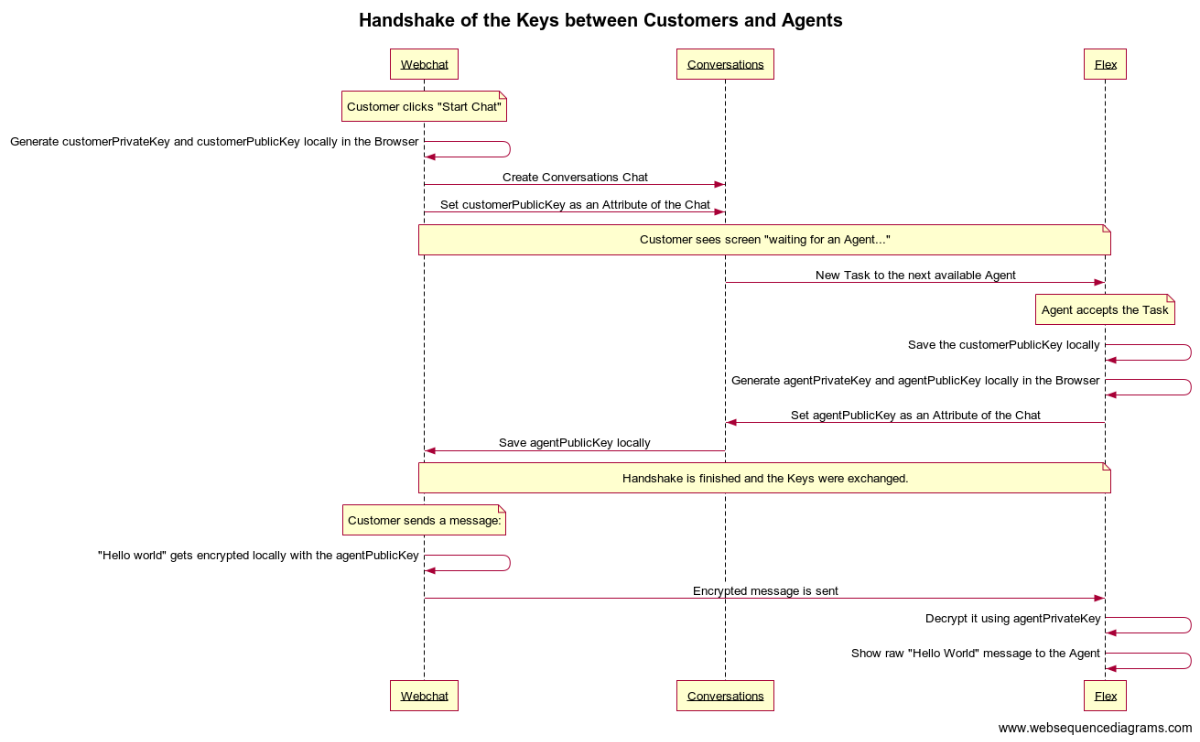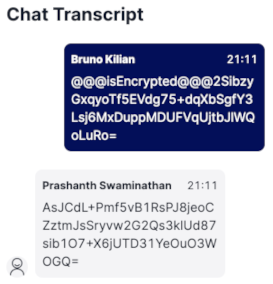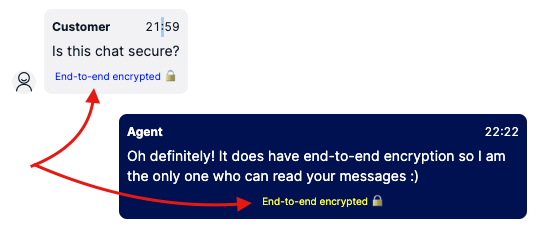End-to-end Encryption for WebChat on Flex
Time to read:

A few months ago, Twilio announced Flex Conversations to empower companies to build tailor-made experiences between Customers and Agents on Flex.
On today's topic, we will be building a secure Webchat communication between the Customers and Agents, so secure that only the Agent and the Customer can read the messages. Not even Twilio will know what is being transmitted - so-called end-to-end encryption.
So what's exciting is, not only messages, but also attachments are end-to-end encrypted! Customers and Agents can exchange files securely. Twilio does store the media being exchanged but - as it is end-to-end encrypted - it is like storing a vault without having the keys to open it.
Do you need end-to-end encryption?
Not all the companies have the need for end to end encryption for all their use cases, however it may be a requirement for companies who have sensitive communication with their customers. Use-cases are:
- Customer from a bank starts the bank Mobile App to talk with their account manager about assets, privately;
- Patient who started a WebChat with his/her Doctor to tell the symptoms in a way that no one else will know apart from the party the information was intended for;
Because Twilio cannot read, process or store these messages once they are end-to-end encrypted, companies and customers can relax knowing the chat messages are completely secure.
End-to-end encryption may also be a great option for European companies who need to comply with Schrems II may have concerns about private consumer data that may be processed or accessed in the US.
How it works
What is end-to-end encryption?
E2E Encryption prevents unintended users, including third parties, from reading or modifying data when only the intended readers should have this access and ability. So essentially, when the user hits the send button, the message is encrypted on the device and is sent to the receiving user, who decrypts the message when the message is received on their decide.
The foundations of e2e encryption is based on top of public key cryptography. The modern way to achieve this is the Diffie–Hellman–Merkle key exchange a method of securely exchanging cryptographic keys over public channels. Nowadays, the recommended key exchange functions to use are Elliptic-curve Diffie–Hellman (ECDH) and in our case we would use the Curve25519-XSalsa20-Poly1305 offering to achieve the encryption and decryption.
We make use of the TweetNacl.js library which is a Javascript port of the original TweetNacl library written in C.
Step by step process
- The communicating parties, the customer and the agent create a pair of private and public keys each. We call it the
customerPrivateKey,customerPublicKeyandagentPrivateKey,agentPublicKey; - The customer shares the
customerPublicKeywith the agent while keeping thecustomerPrivateKeyprivately; - The agent shares the
agentPublicKeywith the customer while keeping theagentPrivateKeyprivately. This ends the key exchange which happens during the beginning of the chat. - The customer while sending a message, encrypts it with the
agentPublicKey. - The agent decrypts the message by using the
agentPrivateKey. - For the agent to encrypt a message the same steps 4 and 5 are used from the agent's perspective.
This sequence diagram shows how this would actually look in our implementation.

Known limitations
Because the end-to-end encryption works like a "tunnel" between the Customer and the Agent and no one else can read the messages, we do have a few expected limitations:
Chat Transfer: The plugin does not allow Chat Transfer from Agent 1 to Agent2. It would be possible but it not covered in this blog post. Extra development is needed to make sure - once the 2nd agent receives and accepts the task - it saves the new publicKey of this 2nd agent into the Conversation so the Customer on the WebChat can encrypt the messages with this new publicKey.
Chat Conference: Adding a third person into the Chat (either customer or agent) will also not work, reason being the same as Chat Transfer: The 3rd-person won't have the privateKey to be able to decrypt the messages, nor will know how which key to use to encrypt the messages to send them over (agentPublicKey or customerPublicKey?) - to make things simpler, we decided to now have Chat Conference at this time.
Park an Interaction: End-to-end encryption does not work with Park an Interaction feature, which is the ability to remove the Agent from a Channel while keeping the Customer in it, for cases when the customer is not so responsive, freeing the Agent to pick another Chat in a meanwhile.
Supervisors can't read the messages: Below is an example of how the Supervisors will see the messages in real-time - it is all encrypted. This happens because the Supervisor does not have the privateKey of the Agent and therefore, cannot decrypt the messages.

Prerequisites
Like the idea of having end-to-end encryption in your WebChat channel? Before continuing, you'll need to walk through all the steps below:
- Flex Instance: you need a Twilio account with a Flex Instance
- Flex UI 2.0: make sure you have Flex instance with UI 2.0 enabled
- Flex Conversations: make sure you have Flex Conversations enabled
- Twilio CLI: Install in your computer our Twilio CLI which is the basis for the next Flex Plugin CLI below.
- Twilio Flex Plugins CLI: Install locally the Flex Plugins CLI to be able to deploy the Flex Plugin to your Flex Instance.
How to install it
Step 1 of 2 - Running the WebChat
- What is it? This is a fork of the open-source WebChat from Twilio, with a bit of extra code to handle the end-to-end encryption.
- Installing: Follow the instructions on how to run the WebChat locally.
Step 2 of 2 - Installing the Flex Plugin
- What is it? The custom Flex Plugin to be installed on Flex (agent side) that will decrypt the messages coming from the WebChat (customers side). See the source-code.
- Installing: Follow the instructions on how to install Flex Plugin here and at the end.
- Testing: If everything went well, you should be able to start an end-to-end conversation visiting http://localhost:3000/ - Once a message arrives on Flex, the Agent should see a label saying "End-to-end encrypted" as shown in the screenshot below.

Wrapping up
That's it! Hope you enjoyed today's session on how to protect your customers even further with end-to-end encryption for WebChat on Flex.
Bruno Kilian and Prashanth Swaminathan are both Senior Solutions Engineer at Twilio. Both are currently helping companies in EMEA design great customer engagement solutions powered by Twilio.
Before, Bruno worked as Tech Lead in an Insurance Contact Center with ~ 600 agents in 4 countries and Prashanth was a Senior developer is software companies dabbling with data science.
Related Posts
Related Resources
Twilio Docs
From APIs to SDKs to sample apps
API reference documentation, SDKs, helper libraries, quickstarts, and tutorials for your language and platform.
Resource Center
The latest ebooks, industry reports, and webinars
Learn from customer engagement experts to improve your own communication.
Ahoy
Twilio's developer community hub
Best practices, code samples, and inspiration to build communications and digital engagement experiences.


